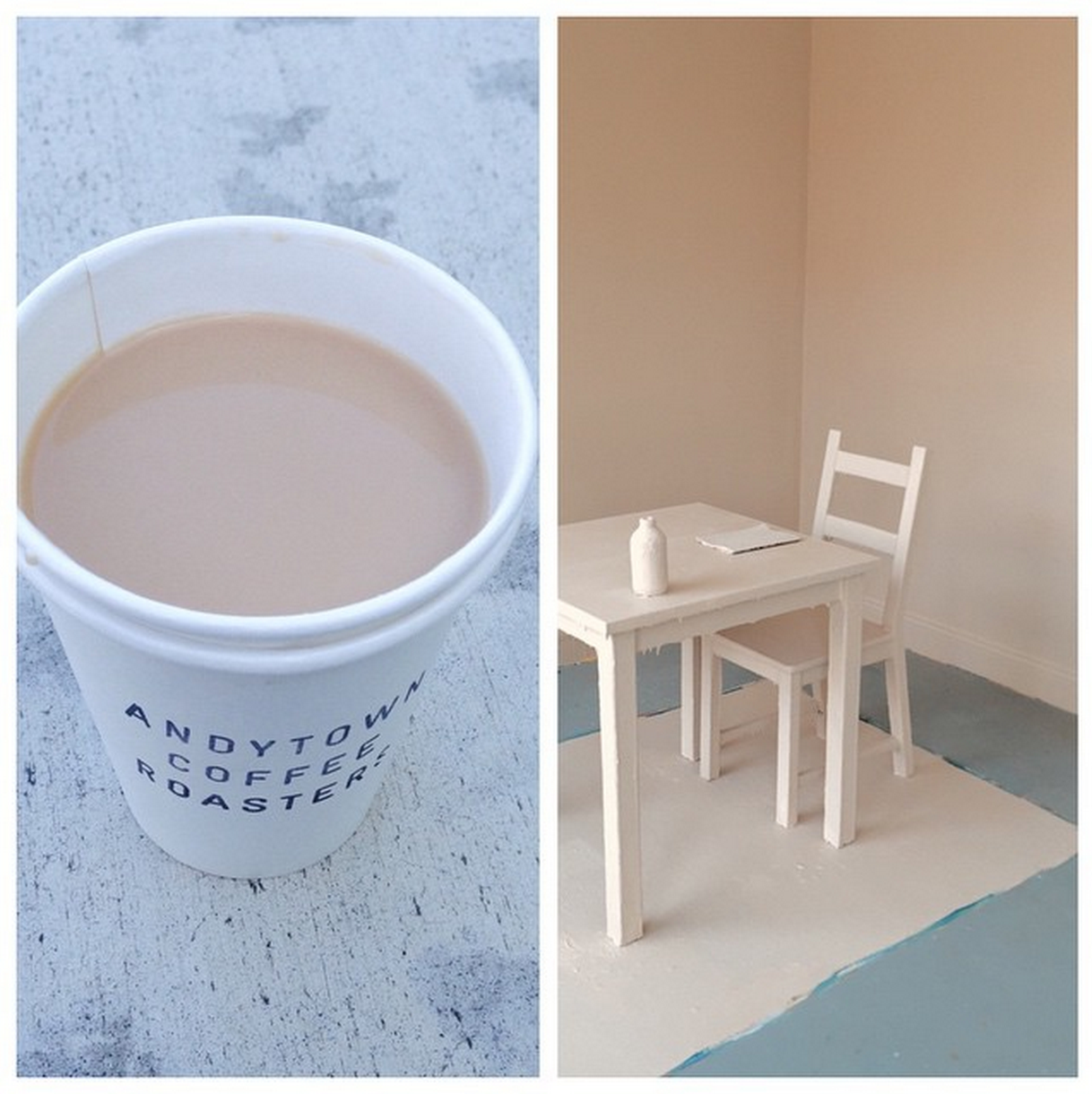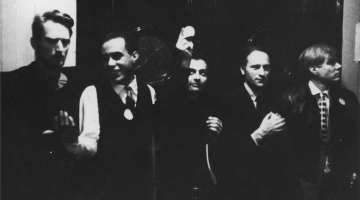Leah Rosenberg
Everyday, a color
30 March–30 May, 2015
Irving Street Projects
4331 Irving Street, San Francisco, CA 94122
Stripe Reveal, Friday, May 15, 2015, entire piece revealed 5-8pm
Fade to White, Friday, May 29, 2015 5-8pm, piece covered
Instagram:
@leahmartharosenberg
@irvingstreetprojects

Leah Rosenberg, Everyday, a color, 2015. Left: source color taken from the world; right: painted gallery at Irving Street Projects. Photo courtesy of Leah Rosenberg.
Leah Rosenberg’s three-month performance painting Everyday, a color references a variety of art historical practices, producing a playful and engaging temporal work housed in the Outer Sunset. It draws specifically upon the traditions of landscape and abstract painting, as well as and through a conceptual art practice. Each day, Rosenberg paints the gallery a new color, leaving behind a stripe of the previous day’s hue. Instead of setting up her paints at a particular location and using the canvas to frame a fixed point within the landscape—a view of the ocean, a piece of a back yard, a street scene—Rosenberg surveys the neighborhood on foot and chooses one color to paint which represents a single object—yellow for oxalis, lime green for a fence, mint for a row of graffiti. This process is highly subjective and abstracts a very specific element of an object while editing out the rest.

Leah Rosenberg, Everyday a color, 2015. Installation view at Irving Street Projects. Photography courtesy of Kate Haug.
Rosenberg photographs her source and uses it to produce a matching paint color, further distancing the color in the gallery from its original point of reference. Rosenberg paints the gallery a new color each day, leaving a painter’s tape width of yesterday’s color on the wall. The final work, once revealed, is an aggregated, abstract landscape painting consisting of color fragments representing the neighborhood. Rosenberg’s painting does not provide context or a fully expressed portrait of the landscape as one might expect. On the contrary, her work visually references Frank Stella’s minimalist paintings of the 1960s in its graphic and sculptural nature, yet the piece does not fully embrace minimalism’s conscious intentionality. As the work is not fully visible until all the tape is removed, it is not entirely under the artist’s control and subject to chance, highlighting its unpredictable and spontaneous nature.

Leah Rosenberg, Everyday, a color, 2015. Left: source color taken from the world; right: painted gallery at Irving Street Projects. Photo courtesy of Leah Rosenberg.

Leah Rosenberg, Everyday, a color, 2015. Left: source color taken from the world; right: painted gallery at Irving Street Projects. Photo courtesy of Leah Rosenberg.
The final piece will be revealed on Friday, May 15. The finished painting will be immensely reflective of the location’s color palette but completely unrecognizable as the local landscape. A viewer would not immediately understand the lines on the walls as representations of the Outer Sunset. Rosenberg’s practice of landscape painting is reminiscent of the subjective mapping projects of early conceptualists like Yoko Ono. At the end of her 1962 Map Piece Ono writes, “Ask your friends to write maps. Give your friends maps.” Indeed, Rosenberg is presenting a new map of the Outer Sunset.
To reinforce her new cartography, Rosenberg led a Color Walk through the Sunset where she showed fellow travelers the objects of her inspiration, bringing the fragments of her landscape into context. Though walkers were following Rosenberg’s map, they were having subjective experiences, letting their eyes wander and focusing on details, which reflected their own interests and curiosities. Through Rosenberg, they were creating maps of their own.

Leah Rosenberg, Everyday, a color, 2015. Left: source color taken from the world; right: painted gallery at Irving Street Projects. Photo courtesy of Leah Rosenberg.
Unlike landscape and abstract painting, Rosenberg’s piece is temporal and will be gone when the show is over. The walls will be painted a final coat of white, returning to their blank form on Friday, May 29, during the last segment of this performance. Even the source objects that Rosenberg chose will change over time: the flowers will fade, the grasses will dry, the houses will be painted another color. The fact that Rosenberg’s document exists in this moment and this moment only underscores the work’s performative quality. Like a neighborhood or a city, Rosenberg’s piece transforms slowly every day. The map is always changing.
Everyday, a color is the inaugural exhibition of Irving Street Projects, the innovative brainchild of artist Kelly Inouye. ISP offers three-month residencies for artists to create experimental installation projects. The space is a storefront with large, street-facing windows, which Inouye has divided: her studio in the back, the artist residency gallery in front. She was inspired to open her studio to other artists as she saw an opportunity to create new projects as the city’s galleries and non-profit spaces dwindle or close. When asked about her plans for the space, Ms. Inouye said, “There’s a long history of artists creating alternative spaces that fill needs that aren’t being met. I try, in my planning of the space and programming at ISP, to incorporate the most meaningful opportunities I’ve had as an artist, which all involve time, dialog, and experimentation. The space is here to be what the artists in residence want it to be, as much as possible, within the context of the neighborhood and community. It’s going to evolve accordingly.”

Leah Rosenberg, Everyday, a color, 2015. Left: source color taken from the world; right: painted gallery at Irving Street Projects. Photo courtesy of Leah Rosenberg.
Everyday, a color seems then to be the perfect opening show as it embraces the gallery’s location and reflects the changing nature of the landscape both visually and culturally. The project’s concise framework conjures many aspects of art history, while being firmly rooted in its immediate surroundings.

Leah Rosenberg, Everyday, a color, 2015. Left: source color taken from the world; right: painted gallery at Irving Street Projects. Photo courtesy of Leah Rosenberg.



